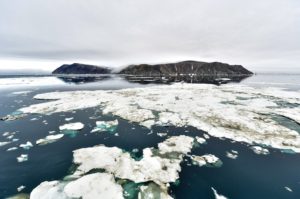Why 1°C Is a Big Deal

To view the photo-rich magazine version, click here.
Originally appears in the Spring 2021 issue.
By Theo Nicitopoulos
It is now common knowledge that since the pre-industrial era, the Earth’s average temperature has increased by about 1°C due to the profound impact that humans have had on the climate system. To many people, this may not sound like much of an increase, but the melting of glaciers and sea ice along with the increase in the frequency and severity of storms, floods, and droughts — to mention but a few examples — signal otherwise. Why does a small increase in the average temperature lead to all of this?
This is an important question to answer when it comes to environmental education, and over the years I have used a variety of teaching strategies to help students discover it. One way that I recently found to be particularly effective was having high school students work with real-life temperature data to explore the effect that a small increase in the average temperature would have on Arctic sea ice.
This content is restricted to subscribers only.
If you are not yet a subscriber, please consider taking out a subscription here.
If you are an existing subscriber, kindly log in or contact us at info@greenteacher.com for more information.





